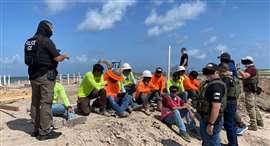Read this article in French German Italian Portuguese Spanish
How US contractors can navigate ICE enforcement and lawful labour pathways
04 July 2025
As immigration enforcement escalates under the Trump administration, the US construction industry faces new pressure to comply with federal law while maintaining access to essential labour.
 US Immigration and Customs Enforcement (ICE) officers question construction workers in Texas’ Rio Grande Valley region. The agency said it arrested 25 undocumented workers at two construction sites as part of enforcement operatoins. (Image: ICE)
US Immigration and Customs Enforcement (ICE) officers question construction workers in Texas’ Rio Grande Valley region. The agency said it arrested 25 undocumented workers at two construction sites as part of enforcement operatoins. (Image: ICE)
Two recent presentations from the Associated General Contractors of America (AGC) lay out a dual strategy for contractors: strengthen legal protections for current workers and expand access to lawful immigration pathways for new hires.
Presented by immigration attorneys Bruce E. Buchanan and Deepti Orekondy, alongside AGC senior director Mike Oscar, the briefings provide a roadmap for firms navigating this increasingly high-risk environment.
ICE prep: what contractors need to know
 Bruce Buchanan
Bruce Buchanan
According to Buchanan and Orekondy, federal agents may initiate action through several routes: an I-9 audit, a workplace raid, or the presentation of administrative or judicial warrants.
Contractors must understand the legal differences between these mechanisms to avoid overstepping or violating worker rights.
I-9 audits typically begin with a Notice of Inspection (NOI), after which employers have three business days to produce I-9 documentation.
Buchanan and Orekondy recommend a full internal audit before ICE ever arrives and strongly advises against backdating or falsifying any forms. Civil fines for violations can range from $272 to $27,108 per worker, depending on the number and nature of the infractions.
If the US Immigration and Customs Enforcement (ICE) agency executes a raid (or “worksite enforcement action”), agents may enter the premises without notice.
In that event, the council advises contractors to:
- Ask for identification and determine whether officers have a judicial search or arrest warrant. If not, employers are not obligated to grant entry beyond public areas.
- Avoid obstructing officers but assign a company representative to monitor the search and document the interaction.
- Refrain from reverifying the immigration status of employees not directly identified in the action, as this could constitute unlawful retaliation.
AGC also urges firms to avoid “self-auditing” their crews in response to political pressure or enforcement trends, which can violate anti-discrimination laws under the Immigration and Nationality Act.
Reducing risk before a raid
 Deepti Orekondy
Deepti Orekondy
To minimise vulnerability, Buchanan and Orekondy outline several proactive steps:
- Conduct regular I-9 compliance reviews with legal oversight.
- Train HR personnel on the difference between administrative and judicial warrants.
- Use E-Verify consistently if enrolled but avoid applying it selectively.
- Prepare an ICE response plan and ensure management is trained to follow it calmly.
They also recommend preparing an attorney contact list, designating a trained response team, and posting signs that distinguish between public and non-public areas in all facilities.
Under US law, ICE agents with an administrative warrant (Form I-9 inspection or detainer request) can only legally enter areas of a workplace that are open to the public, like a front lobby or reception area, unless they have a judicial warrant signed by a judge.
Expanding the legal workforce: pathways for lawful immigration
 Mike Oscar
Mike Oscar
Temporary Protected Status (TPS) and Deferred Action for Childhood Arrivals (DACA) are two of the most common protections in place for many construction workers today.
AGC’s Mike Oscar encourages contractors to understand these categories, but not to verify or challenge individual status, in order to grasp the scale of workers legally present under such programs.
For future hiring, Oscar highlights several pathways:
- H-2B visas (for non-agricultural seasonal work) may offer limited short-term relief. However, the program is capped and highly competitive.
- Employment-based green cards and the EB-3 visa category could allow contractors to sponsor foreign nationals in skilled or unskilled roles, though processing times remain long.
- Apprenticeship programs that qualify for immigration benefits or labour certifications can serve as a long-term pipeline for talent.
Oscar also notes that many workers may be eligible for Adjustment of Status through family-based sponsorship or humanitarian relief pathways, and employers should work with immigration attorneys to identify appropriate routes where relevant.
Final advice
AGC cautions against assuming immigration enforcement will taper off any time soon.
The association instead encourages members to build internal capacity for compliance, understand the legal boundaries of ICE interaction, and proactively invest in lawful labour channels.
As Buchanan and Orekondy write in the presentation, “Compliance is not an event – it is an ongoing process.”
STAY CONNECTED



Receive the information you need when you need it through our world-leading magazines, newsletters and daily briefings.
CONNECT WITH THE TEAM









